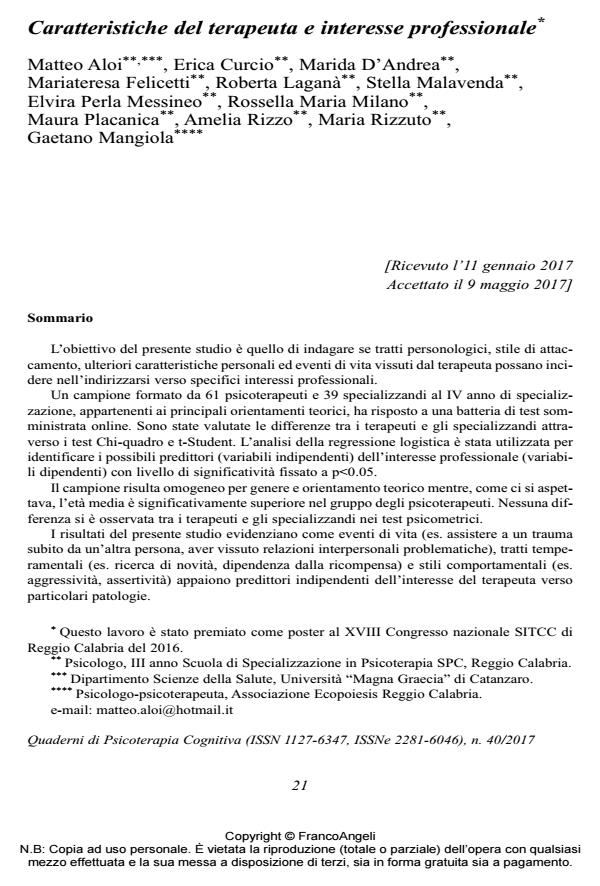Therapist’s characteristics and professional interest
Journal title QUADERNI DI PSICOTERAPIA COGNITIVA
Author/s Matteo Aloi, Erica Curcio, Marida D’Andrea, Mariateresa Felicetti, Roberta Laganà, Stella Malavenda, Elvira Perla Messineo, Rossella Maria Milano, Maura Placanica, Amelia Rizzo, Maria Rizzuto, Gaetano Mangiola
Publishing Year 2017 Issue 2017/40
Language Italian Pages 17 P. 21-37 File size 144 KB
DOI 10.3280/QPC2017-040002
DOI is like a bar code for intellectual property: to have more infomation
click here
Below, you can see the article first page
If you want to buy this article in PDF format, you can do it, following the instructions to buy download credits

FrancoAngeli is member of Publishers International Linking Association, Inc (PILA), a not-for-profit association which run the CrossRef service enabling links to and from online scholarly content.
The aim of this study is to investigate whether personality traits, attachment style, other variables concerning personal characteristics and life events experienced by the therapist can influence his/her own professional interest. A sample of 61 psychotherapists and 39 students at the fourth year of specialization in psychotherapy, belonging to the main theoretical approaches, answered to an online test battery. The differences between the therapists and residents were evaluated through Chi-square and t-Student. The logistic regression analysis was used to identify possible predictors (independent variables) of professional interests (dependent variables) with significance level set at p<0.05. The sample was homogenous in gender and theoretical orientation while, as expected, the average age was significantly higher in the group of psychotherapists. No differences were observed between the therapists and residents in psychometric tests. Our results showed that life events (eg. experienced a trauma suffered by another person, a punitive educational style received, interpersonal problems), temperamental traits (eg. novelty seeking, reward dependence) and behavioral styles (eg. aggressiveness, assertiveness) were independent predictors of interest therapist to particular diseases.
Keywords: Therapist characteristics, therapist experiences, personality, theoretical orientation.
Matteo Aloi, Erica Curcio, Marida D’Andrea, Mariateresa Felicetti, Roberta Laganà, Stella Malavenda, Elvira Perla Messineo, Rossella Maria Milano, Maura Placanica, Amelia Rizzo, Maria Rizzuto, Gaetano Mangiola, Caratteristiche del terapeuta e interesse professionale in "QUADERNI DI PSICOTERAPIA COGNITIVA" 40/2017, pp 21-37, DOI: 10.3280/QPC2017-040002